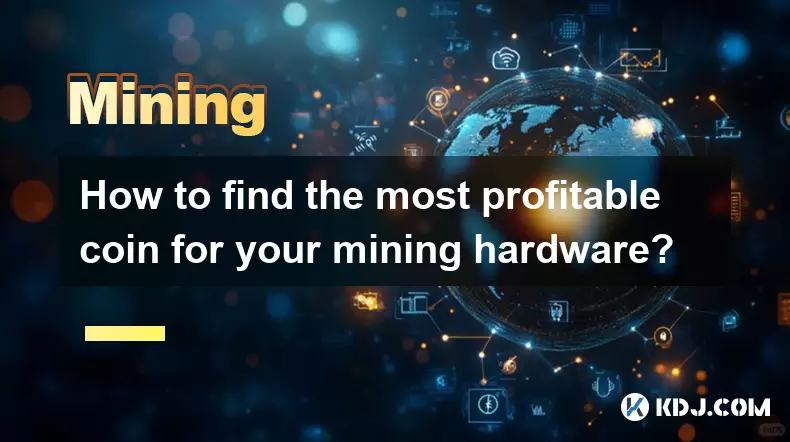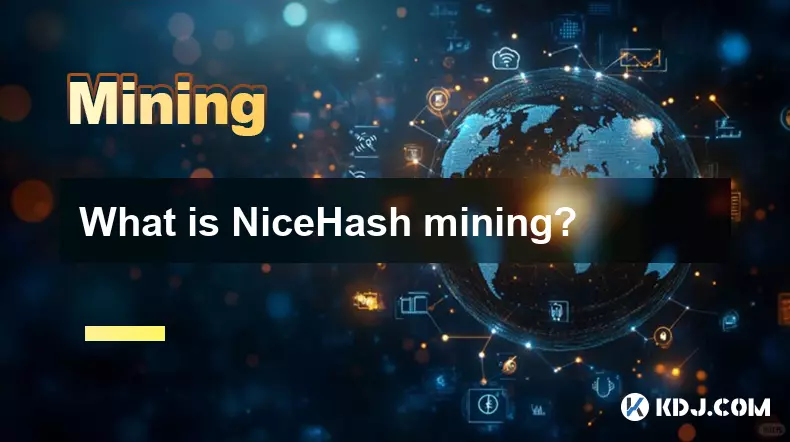-
 bitcoin
bitcoin $105968.894684 USD
4.17% -
 ethereum
ethereum $3639.320047 USD
7.62% -
 tether
tether $1.000339 USD
0.06% -
 xrp
xrp $2.407774 USD
5.96% -
 bnb
bnb $1011.704193 USD
2.28% -
 solana
solana $166.942754 USD
6.37% -
 usd-coin
usd-coin $1.000143 USD
0.03% -
 tron
tron $0.291515 USD
0.25% -
 dogecoin
dogecoin $0.181682 USD
4.06% -
 cardano
cardano $0.585450 USD
4.54% -
 hyperliquid
hyperliquid $42.099968 USD
5.20% -
 chainlink
chainlink $16.160745 USD
5.45% -
 zcash
zcash $645.269648 USD
12.96% -
 bitcoin-cash
bitcoin-cash $507.430338 USD
2.80% -
 stellar
stellar $0.290357 USD
3.69%
How to find the most profitable coin for your mining hardware?
Choose coins matching your rig’s algorithm and efficiency, use profitability calculators, monitor difficulty shifts, join reliable pools, and consider low-cap altcoins for early gains.
Oct 24, 2025 at 10:00 pm

Finding the Best Cryptocurrency for Your Mining Rig
1. Identify your hardware specifications including hash rate, power consumption, and compatibility with different mining algorithms. Knowing whether your rig supports SHA-256, Ethash, Scrypt, or other algorithms is crucial to narrowing down suitable coins.
2. Use online profitability calculators such as WhatToMine, MinerStat, or NiceHash Profitability Tool. These platforms allow you to input your GPU or ASIC model and instantly compare estimated earnings across hundreds of cryptocurrencies based on current network difficulty and market prices.
3. Consider electricity costs in your region. A coin might appear profitable on paper, but high power draw can erase margins. Look for coins that offer high hashrate efficiency per watt, especially if energy rates are steep where you operate.
4. Evaluate network stability and longevity. Some lesser-known coins experience rapid price spikes followed by collapses or disappear due to abandoned development. Prioritize projects with active communities, regular updates, and listings on reputable exchanges.
Monitoring Market Trends and Difficulty Shifts
1. Track real-time changes in mining difficulty. When a coin becomes more popular to mine, difficulty increases, reducing individual payouts. Sudden surges often follow price rallies or exchange listings—stay ahead by monitoring blockchain explorers and mining pool statistics.
2. Subscribe to crypto analytics dashboards like CoinGecko, Glassnode, or CryptoQuant. These tools provide insights into trading volume, miner reserves, and on-chain activity that indirectly affect mining viability.
3. Follow developer announcements and hard fork schedules. Protocol upgrades may alter consensus mechanisms (e.g., Ethereum’s shift from Proof-of-Work), rendering certain hardware obsolete unless adapted.
4. Watch for seasonal trends. For example, Bitcoin mining becomes less profitable during halving events until price adjusts. Anticipating these shifts helps avoid locking into underperforming assets.
Optimizing Pool Selection and Payout Structures
1. Choose mining pools with low downtime, transparent fee structures, and geographic proximity to reduce latency. Large pools like F2Pool, Ethermine, or Slush Pool offer consistency but may charge 1–3% fees.
2. Compare payout methods: Pay-per-Share (PPS) offers steady income but higher fees; Proportional or Pay-per-Last-N-Shares (PPLNS) reward loyalty and long-term participation, benefiting consistent miners.
3. Verify pool decentralization. Over-concentration of hashrate in one pool poses centralization risks and could lead to temporary bans or censorship, affecting your ability to submit valid shares.
4. Test smaller niche pools offering bonus rewards for rare blocks or community incentives. Some altcoin pools distribute additional tokens or NFTs to active participants, increasing overall yield.
Maximize uptime and monitor rejected shares through reliable software like HiveOS or RaveOS, which provide remote management and automatic failover features critical for sustained profitability.
Adapting to Algorithm-Specific Opportunities
1. Explore memory-hard algorithms like KawPow (used by Ravencoin) or Autolykos (Ergo), which favor GPUs over ASICs, leveling the playing field for home miners.
2. Investigate dual-mining setups where possible. Platforms like NHML support dual mining of Ethereum Classic alongside Beam or Zilliqa, effectively doubling revenue without extra hardware.
3. Stay alert for new launches using fair-distribution models. Coins like Vertcoin or Monero emphasize resistance to centralized mining, making them ideal targets for consumer-grade equipment.
4. Audit firmware compatibility. Flashing custom BIOS on GPUs can improve power limits and core clocks, directly boosting performance on algorithm-specific workloads like Cuckoo Cycle or RandomX.
Frequently Asked Questions
What factors make a cryptocurrency unsuitable for my mining setup?Coins requiring specialized hardware like ASICs are impractical for GPU miners. High memory bandwidth demands or frequent DAG size increases can also strain older cards. Additionally, coins with volatile difficulty spikes or unreliable payout histories increase operational risk.
How often should I switch mining coins?Switching weekly or even daily may be necessary during periods of high volatility. Automated switching services like MultiMiner or mining orchestrators integrated with APIs can dynamically redirect hashing power to the most profitable option at any given moment.
Can cloud mining contracts compete with personal hardware returns?In most cases, cloud mining lacks transparency and carries high counterparty risk. Hidden maintenance fees, unrealistic ROI projections, and contract lock-ins often result in negative returns compared to self-owned rigs with controlled overhead.
Is it worth mining low-market-cap altcoins?Mining small-cap coins can be lucrative if timed correctly. Early adoption allows accumulation before exchange listings drive price appreciation. However, this strategy requires thorough research into project fundamentals and exit liquidity to avoid holding illiquid assets.
Disclaimer:info@kdj.com
The information provided is not trading advice. kdj.com does not assume any responsibility for any investments made based on the information provided in this article. Cryptocurrencies are highly volatile and it is highly recommended that you invest with caution after thorough research!
If you believe that the content used on this website infringes your copyright, please contact us immediately (info@kdj.com) and we will delete it promptly.
- Ripple (XRP) in 2026: Hold or Fold? A Look at XRP's Future and Emerging DeFi Alternatives
- 2025-11-08 18:35:01
- Zcash ZEC Coin Price Explosion: From Privacy Niche to Center Stage
- 2025-11-08 18:55:01
- Berachain Price Prediction: Navigating the Honeycomb Hype in Crypto
- 2025-11-08 18:55:01
- Arthur Hayes, Gold, and Bitcoin: A Modern Monetary Trinity?
- 2025-11-08 19:15:01
- Shiba Inu's Next Move: Navigating a Shifting Market
- 2025-11-08 19:20:01
- Pakistan's Crypto Crossroads: Balancing Opportunity with Asset-Backed Realities
- 2025-11-08 19:20:01
Related knowledge

What is the block reward in mining?
Nov 06,2025 at 12:35am
Understanding Block Rewards in Cryptocurrency Mining1. The block reward is the incentive miners receive for successfully validating and adding a new b...

How do mining algorithms work?
Nov 06,2025 at 04:59am
Mining Algorithms and Their Role in Blockchain Networks1. Mining algorithms serve as the backbone of blockchain consensus mechanisms, ensuring that tr...

What is NiceHash mining?
Nov 06,2025 at 07:40am
NiceHash mining refers to the process of renting out computational power to individuals or organizations seeking to mine cryptocurrencies without owni...

Does an antivirus program affect mining?
Nov 05,2025 at 09:29pm
Understanding Decentralized Exchanges in the Crypto Ecosystem1. Decentralized exchanges (DEXs) operate without a central authority, allowing users to ...

What is the history of Bitcoin mining?
Nov 05,2025 at 08:15pm
Within the fast-moving world of cryptocurrency, new developments emerge daily, reshaping how investors, developers, and institutions interact with dig...

How is the energy consumption of mining justified?
Nov 05,2025 at 10:20pm
Energy Consumption in Cryptocurrency Mining1. The energy consumption associated with cryptocurrency mining has drawn significant attention from enviro...

What is the block reward in mining?
Nov 06,2025 at 12:35am
Understanding Block Rewards in Cryptocurrency Mining1. The block reward is the incentive miners receive for successfully validating and adding a new b...

How do mining algorithms work?
Nov 06,2025 at 04:59am
Mining Algorithms and Their Role in Blockchain Networks1. Mining algorithms serve as the backbone of blockchain consensus mechanisms, ensuring that tr...

What is NiceHash mining?
Nov 06,2025 at 07:40am
NiceHash mining refers to the process of renting out computational power to individuals or organizations seeking to mine cryptocurrencies without owni...

Does an antivirus program affect mining?
Nov 05,2025 at 09:29pm
Understanding Decentralized Exchanges in the Crypto Ecosystem1. Decentralized exchanges (DEXs) operate without a central authority, allowing users to ...

What is the history of Bitcoin mining?
Nov 05,2025 at 08:15pm
Within the fast-moving world of cryptocurrency, new developments emerge daily, reshaping how investors, developers, and institutions interact with dig...

How is the energy consumption of mining justified?
Nov 05,2025 at 10:20pm
Energy Consumption in Cryptocurrency Mining1. The energy consumption associated with cryptocurrency mining has drawn significant attention from enviro...
See all articles





















![The Graph Price Prediction [GRT Crypto Price News Today] The Graph Price Prediction [GRT Crypto Price News Today]](/uploads/2025/11/07/cryptocurrencies-news/videos/690d4df44fe69_image_500_375.webp)




















































